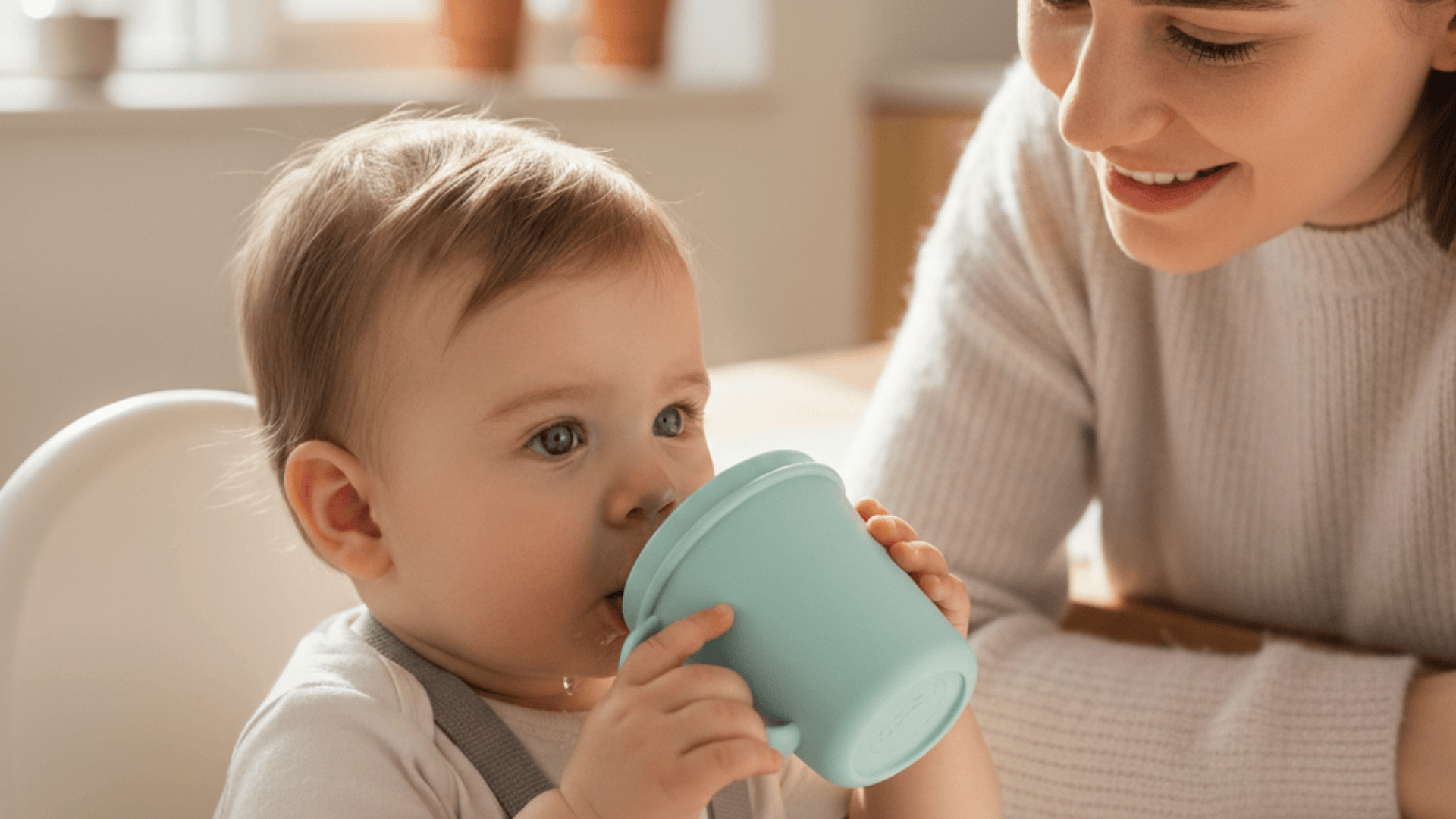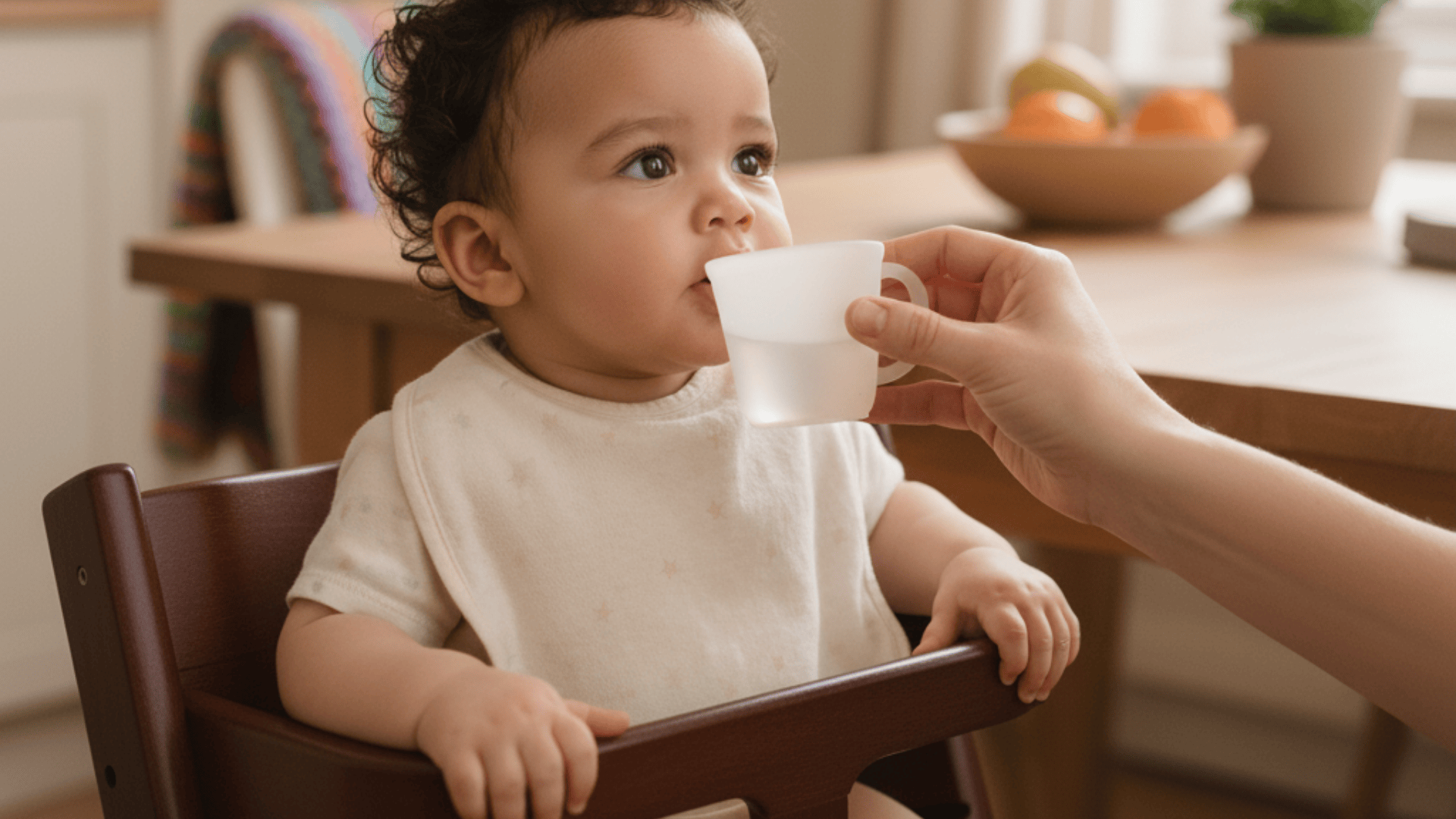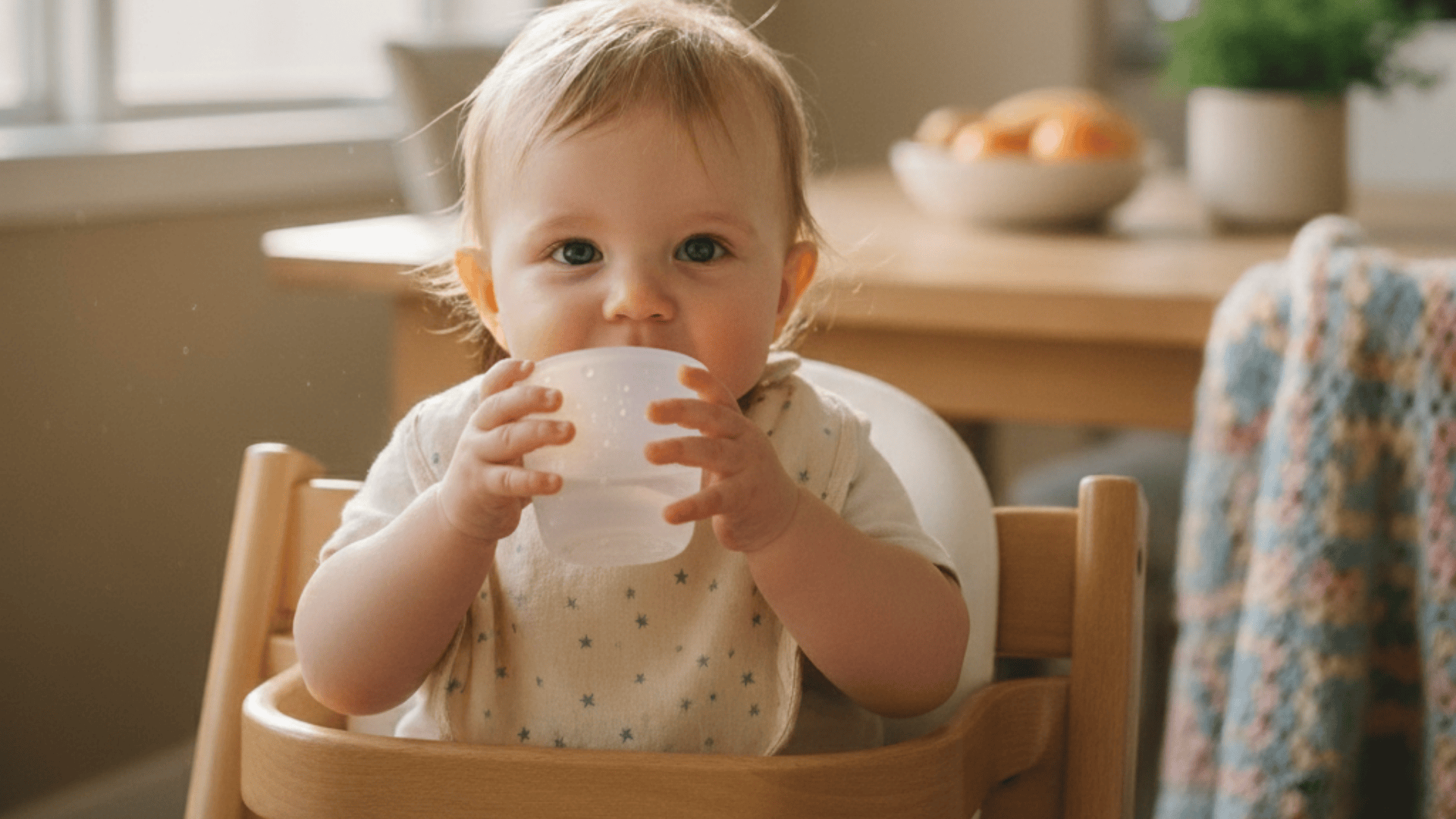Many parents feel unsure about when and how to start giving water once their baby begins eating solids.
It’s common to wonder how much is safe or if water is even necessary at this stage.
Breast milk or formula should still be your baby’s main source of hydration and nutrition during the first year. Water is simply a small addition that helps your baby learn new skills like sipping and swallowing.
In this blog, you’ll find clear, AAP-based recommendations, simple mL-to-oz conversions, and step-by-step tips to safely introduce water to your 6-month-old.
When Can Babies Start Drinking Water?
Babies shouldn’t drink water before they reach 6 months of age. At this stage, their tiny stomachs are still developing, and water can fill them up too quickly.
That means they might drink less breast milk or formula, which are their main sources of nutrition and hydration.
Once your baby starts eating solid foods, small amounts of water can be introduced. This helps them learn how to sip, stay hydrated with their new foods, and get used to drinking from a cup.
Safe Quantity of Water for a 6-Month-Old Baby

At 6 months, babies can have small amounts of water along with breast milk or formula. Water supports digestion and helps them adjust to eating solids, but too much can fill their stomach and reduce milk intake.
1. AAP and Pediatric Recommendations
TheAmerican Academy of Pediatrics (AAP) recommends 4–8 ounces (120–240 mL) of water per day once your baby reaches 6 months.
This amount keeps them hydrated without replacing breast milk or formula, which should remain their main drink until 12 months. Offer water in small sips throughout the day; a few after each meal is enough.
2. Formula-Fed vs. Breastfed Babies
- Breastfed babies: They usually need less water because breast milk naturally adjusts to their hydration needs, even in warmer weather.
- Formula-fed babies: They may benefit from small, consistent sips of water, especially when solids are introduced, as formula is thicker and less hydrating than breast milk.
In both cases, water should never replace a feeding. Think of it as an addition, not a substitute; just a small supplement alongside regular milk or formula.
3. Simple Conversion Chart (oz ↔ mL)
Here’s an easy conversion chart to help you measure water accurately. Start near the lower end of the range and increase gradually as your baby becomes comfortable.
| Water (oz) | Water (mL) |
|---|---|
| 2 oz | 60 mL |
| 4 oz | 120 mL |
| 6 oz | 180 mL |
| 8 oz | 240 mL |
4. Adjustments for Hot Weather or Active Babies
When the weather is hot or your baby is more active than usual, their body may lose extra fluids through sweat. In such cases, you can offer a little more water to keep them comfortable and hydrated.
Babies around 6 months can safely have up to 8 ounces (240 mL) of water per day, but it’s best to give it in small, frequent sips instead of all at once.
How to Introduce Water Safely

Introducing water to your baby is a gentle process. The goal is to help them learn how to sip and swallow safely without replacing their regular milk feeds.
1. Start Slow: A Few Sips After Meals
When you begin offering water, think of it as a learning experience rather than a new feeding routine. Your baby’s main nutrition and hydration should still come from breast milk or formula.
Start by offering just a few sips of water once or twice a day, especially after solid meals. This helps your baby get used to the taste and motion of drinking without filling their tummy too much.
- Offer 2–3 teaspoons (10–15 mL) at first.
- Increase gradually over a few weeks.
- Keep it relaxed: no need to force them to drink.
These small sips also help wash down solid food and support digestion while keeping mealtime positive and pressure-free.
2. Use a Sippy, Open, or Straw Cup
Around 6 months, babies begin developing the coordination needed to drink from a cup. This is a great time to help them learn new sipping skills while moving away from bottles. Avoid bottles for water since they encourage sucking instead of sipping.
Try these cup options:
- Sippy cup: Great for beginners and easy to hold.
- Open cup: Promotes coordination and oral control.
- Straw cup: Strengthens mouth muscles and supports speech later on.
Let your baby practice freely. Each sip helps build confidence and independence, turning drinking water into a fun and skill-building part of their daily routine.
3. Signs Your Baby is Ready
Every baby is different, but there are a few clear signs that show yours is ready to start drinking small amounts of water. Paying attention to these cues ensures your baby’s safety and comfort.
Your baby might be ready if:
- They can sit up with minimal support.
- They show interest in what you’re drinking.
- They’ve started eating solid foods regularly.
- They can close their mouth around the edge of a spoon or cup.
These signs mean your baby’s muscles and swallowing reflexes are mature enough to handle small sips of water safely and comfortably.
4. Tips If Baby Refuses Water
Some babies refuse water at first because it tastes different from milk or formula. That’s completely normal, just keep offering it calmly. Try these simple ideas to encourage them:
- Offer water in colorful or fun cups.
- Serve it slightly warm or at room temperature.
- Give a few sips after playtime or outdoor walks.
- Change the cup type or timing sometimes.
If your baby still refuses but eats solids and drinks milk or formula, don’t worry. They’re still getting enough fluids from food and regular feeds.
Practical Daily Water Schedule Example
A simple daily water routine helps keep your 6-month-old hydrated without disrupting their milk feeds.
In the morning, offer about 2 ounces (60 mL) of water after solid foods to help with swallowing and digestion.
In the afternoon, give another 2 ounces (60 mL) after a milk feed to refresh your baby, especially during warmer hours.
In the evening, offer 2–4 ounces (60–120 mL) depending on your baby’s thirst and comfort level.
Always provide water in small, gentle sips using a sippy or open cup, and make sure to use boiled and cooled water to keep it safe for your baby’s developing immune system.
Signs of Dehydration and Overhydration in Babies
Finding the right water balance is important as babies are more sensitive to changes in fluid levels. Both too little and too much water can affect their health. Recognizing the signs of each helps you keep your baby safe, hydrated, and healthy.
Signs of Dehydration in Babies
- Early signs: Dry lips or mouth, dark yellow urine, or fewer than six wet diapers in a day.
- Behavior changes: Your baby might seem tired, unusually fussy, or have a sunken soft spot on their head.
- What to do: Offer more breast milk or formula to replace lost fluids. Avoid plain water unless your doctor recommends it.
- When to get help: Call your pediatrician if your baby hasn’t peed for 8 hours, looks weak, or shows signs of severe dehydration.
Signs of Overhydration in Babies
- Main concern: Extra water can dilute sodium levels, leading to water intoxication, which affects brain function.
- What to watch for: Unusual sleepiness, puffiness (especially around the face), irritability, or in rare cases, seizures.
- Feeding problems: Drinking too much water can make babies feel full and reduce how much milk or formula they take in.
- Safe amount: Stick to breast milk or formula for hydration, and only give small sips of water after 6 months, and only if your doctor says it’s okay.
Maintaining the right balance helps keep your baby hydrated, healthy, and comfortable every day.
Conclusion
Every baby is different, and their needs can vary depending on feeding habits, activity level, and climate.
If you’re unsure how much water your baby needs or notice changes in feeding or diaper output, it’s best to talk to your pediatrician.
Babies around 6 months can safely start sipping small amounts of water. It helps them practice drinking and supports digestion, but breast milk or formula should still be their main source of nutrition through the first year.
With a little attention and care, you can keep your baby healthy, hydrated, and growing happily every day.










